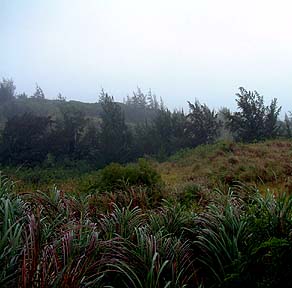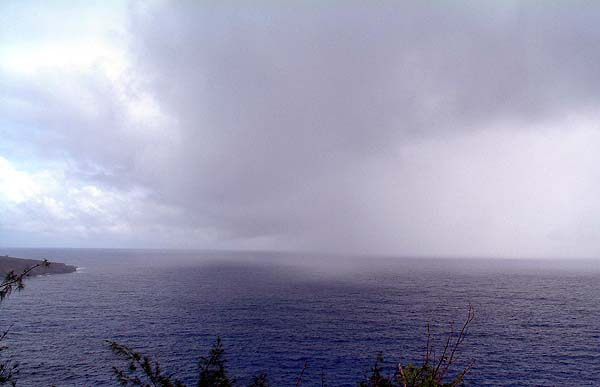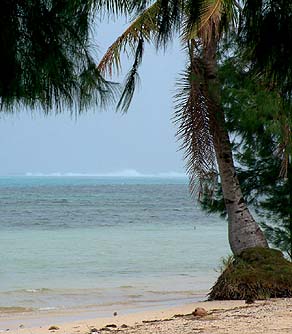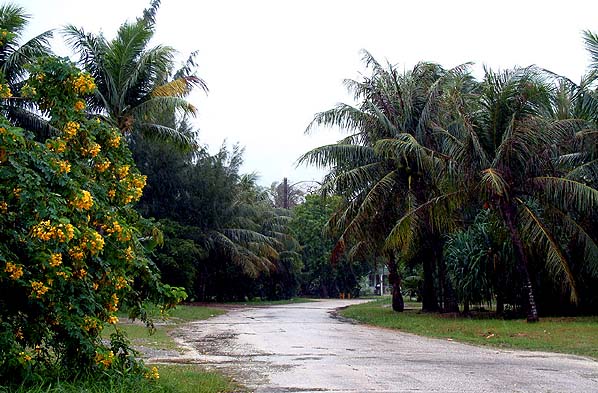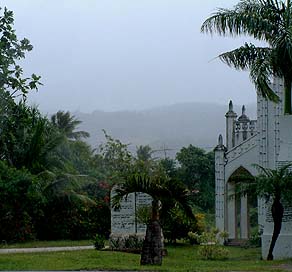 |
 |
 |
|||||
|
|
|
|
|
|
|
|
|
|
|
|||||||
|
|
|
|
Rain descending upon the mountain above Tanapag.
|
|
“We don’t have the four seasons, we have two,” Ben says, “and these two seasons are unlike summer and winter. They are actually associated with rain. During the rainy season, we call it a pronounced wet season, and during dry season we call it a pronounced dry season. The rainy season for us starts in July and ends in probably the last part of December or the mid part of January. From the mid part of January to July we have the dry season.”
|
||
|
|
||
“In Chamorro we just say tempon uchan and tempon somnak, ‘time of rain’ and ‘time of sun.’ That’s the literal translation. There’s no actual transition. But the rainy season is associated with typhoon, so we’re more concerned about devastating wind during the wet season than the dry season. "Now we’re hearing about El Niño, La Niña and stuff like that. It’s a recent understanding of the rise of the sea associated with heat and maybe the dissipation of heat."
|
|
|
“Knowledge about the wind that brings rain is a practice we learned because of agriculture and fishing. During the rainy season, we like to stay inside the lagoon. Greater abundance of fish is associated with a lot of rain, and this is true in a biological sense because there will be a lot of effluents going out into the ocean that provide a lot of nutrients, so fish are in abundance because they come in and feed on a lot of these effluents from the land." "When wind brings rain for agriculture we call it primed di agua, ‘first water,’ and that’s good for the people who practice agriculture. It coincides with their planting schedule, with what crops to plant during this rainy time. There are plants that of course prefer the dry season, and you have to irrigate them, but plants that enjoy natural rain, farmers will remember to plant them during this time of the season."
|
|
|
|
|
Chamorro Months |
Translation: |
Carolinian Months |
Star/Constellation: |
Tumaiguini |
"Like this; thus" |
Schoow |
Corona Borealis |
Maimo |
(no translation) |
Mááischigh |
(unknown) |
Umatalaf |
"To go catch Gatafe fish" |
Mááilap |
Altair |
Lumuhu |
"To go back, return the attack" |
Sééta |
(unknown) |
Makmamao |
(no translation) |
Ghúúw |
Aries |
Mananaf |
"The crawling time" |
Alimaté |
(unknown) |
Semo |
(no translation) |
Wuun |
Aldebaran |
Tenhos |
"Angry" |
Elúwel |
Orion’s belt |
Lumamlam |
"Lightning" |
Maan |
Sirius |
Fanggualo' |
"Planting time" |
Sarobwél |
Corvus |
Sumongsong |
"To put in the stopper" |
Aremwoy |
Arcturus |
Umayanggan |
"Troubled melancholy" |
Tumwur |
Antares |
| Umagahaf |
"To get crawfish" |
|
|
|
||
|
"But the winds which bring rains that coincide with the high tide and low tide, we have those names also. We call them uchan ma’te for the tide rain, uchan hafnot for the high tide rain. Ma’te is a general term for 'tide,' but then we have hafnot and ma’te; hafnot means 'high tide' and ma’te means 'low tide.' "And from those winds we know the tides. When the rain falls at that particular time as the wind is blowing, we feel it. Even if I’m sitting here and it rains, I can tell you now that it’s high tide. Without even going out to the ocean and observing the changes of tide, we’ll be able to say ‘ah, it’s high tide now’, and we associate that with this certain combination of wind and rain. "After many observations, the pattern of the rain and the time (whether it's during the day or during the night) tell us that particular kinds of rain can be associated with other things that are happening."
|
||
|
|
||
"There’s another rain that we call uchan maotai, which means the ‘rain of death.’ I could be sitting here and if it rains with the sun out and raining down, I’d say ‘Ah, somebody died.’ It just kind of tells us that; I'd say a more than 50% chance that somebody died. We associate all of that with natural things that are happening." “When there’s a heavy cloud with rain and there’s the sun and it rains,” Rosa Castro says, “we call that the ‘rain of sickness’ or the ‘sick rain.’ If there’s a rainbow and it rains, that’s what they call uutimaay. That’s the ‘rain of death.’ The children cannot go out under that kind of rain."
|
|
|
“When the sun is shining and there’s a rain, we say that somebody is going to die,” Joaquina explains “and also we say it’s ‘fire rain,’ úshow malame. That kind also, we tell our kids not to be under, and not to be caught by, because they might get sick. “The sun’s still up there and there’s light and rain,” Yoane adds, “that kind of rain is not good for us, because it rains something bad.” “The name of the rainbow is isa in Chamorro,” Ben adds, “Anúúmwarahi, that’s the rainbow in Carolinian. Rásiim is also another name for the rainbow. It is associated with this ‘rain of death.’ The older folks, when they see the rainbow and rain, they call that the ‘rain of death’.”
|
"When there is a sudden end to the rain, and there is no dripping of the rain, we say someone is going to have a baby. We call it 'instant rain.' When we see that, we say ‘Oh, I wonder who’s going to deliver?’ “Like when we’re sitting outside and the rain just comes,” Cathy says, “then stops right there, like maybe the wind blows it away, we call that 'instant rain.' Our belief is that somebody is going to have a baby.” “Pouring rain, when it’s really raining, that’s úshow,” Joaquina states. “It’s a healthy rain. We can use it to catch our drinking water, because we believe that when it’s really pouring, it washes out the dirt first, and then you can catch what’s next. That’s a really heavy rain.” |
|
|
|
|
Road in Tanapag on a rainy day.
|
“In the rainy season, we used to go to the other side of the island and there is this swampy area that, when it’s low tide, or when it’s rainy season, we chase a kind of milk fish” Noel recalls. “It’s actually first a freshwater fish, but then it evolves. These fish deliver their eggs in the freshwater and then go out to sea. The baby fish grows in freshwater, where it hatches from the egg, but then after that it goes out to the ocean. We always chased the fish, when the rainy season came and the water would just come rushing down.”
|
||
|
|
||
"We have a phenomenon called the hundred-year rain," Ben remarks, "and the hundred-year rain comes supposedly every 100 years. There was a big flood that happened, and people primarily from the south were really flooded out. They had to be evacuated. "The hundred-year rain occurred in 1978; that’s supposed to be the time that it occurs. But we aren't sure that it was 1878 when we last had a rain of that magnitude, because we didn’t have any records then."
|
|
|
"That time in 1978, the water rose to the point where the flood was damaging to the island. Hagoi and the area around Susupe Lake were really flooded, but not here. "We had a lot of rain. The river rose up, the creek became very pronounced and dumped out a lot of things from the military dump up the hill. All of these cans and airplane parts and guns and canteens were floating all over the ocean."
|
|
|
|
The rain in Saipan is substantial enough to provide for forest.
|
||
|
|
||
|
|
|
|
|
|

|
| Tanapag Home | Map Library | Site Map | Pacific Worlds Home |
|
|
|
|

|
|
|
|||
| Copyright 2003 Pacific Worlds & Associates • Usage Policy • Webmaster |
|||


